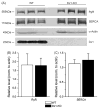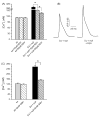Altered Ca2+ homeostasis in the skeletal muscle of DJ-1 null mice
- PMID: 19683835
- PMCID: PMC2888942
- DOI: 10.1016/j.neurobiolaging.2009.07.010
Altered Ca2+ homeostasis in the skeletal muscle of DJ-1 null mice
Abstract
Loss-of-function mutations in DJ-1 are associated with early-onset of Parkinson's disease. Although DJ-1 is ubiquitously expressed, the functional pathways affected by it remain unresolved. Here we demonstrate an involvement of DJ-1 in the regulation of Ca(2+) homeostasis in mouse skeletal muscle. Using enzymatically dissociated flexor digitorum brevis muscle fibers from wild-type (wt) and DJ-1 null mice, we examined the effects of DJ-1 protein on resting, cytoplasmic [Ca(2+)] ([Ca(2+)](i)) and depolarization-evoked Ca(2+) release in the mouse skeletal muscle. The loss of DJ-1 resulted in a more than two-fold increase in resting [Ca(2+)](i). While there was no alteration in the resting membrane potential, there was a significant decrease in depolarization-evoked Ca(2+) release from the sarcoplasmic reticulum in the DJ-1 null muscle cells. Consistent with the role of DJ-1 in oxidative stress regulation and mitochondrial functional maintenance, treatments of DJ-1 null muscle cells with resveratrol, a mitochondrial activator, or glutathione, a potent antioxidant, reversed the effects of the loss of DJ-1 on Ca(2+) homeostasis. These results provide evidence of DJ-1's association with Ca(2+) regulatory pathways in mouse skeletal muscle, and suggest the potential benefit of resveratrol to functionally compensate for the loss of DJ-1.
Copyright © 2009 Elsevier Inc. All rights reserved.
Conflict of interest statement
There are no actual or potential conflicts of interest.
Figures




Similar articles
-
DJ-1 links muscle ROS production with metabolic reprogramming and systemic energy homeostasis in mice.Nat Commun. 2015 Jun 16;6:7415. doi: 10.1038/ncomms8415. Nat Commun. 2015. PMID: 26077864 Free PMC article.
-
Functional and biochemical properties of ryanodine receptor type 1 channels from heterozygous R163C malignant hyperthermia-susceptible mice.Mol Pharmacol. 2011 Mar;79(3):420-31. doi: 10.1124/mol.110.067959. Epub 2010 Dec 14. Mol Pharmacol. 2011. PMID: 21156754 Free PMC article.
-
Ca2+ release in muscle fibers expressing R4892W and G4896V type 1 ryanodine receptor disease mutants.PLoS One. 2013;8(1):e54042. doi: 10.1371/journal.pone.0054042. Epub 2013 Jan 7. PLoS One. 2013. PMID: 23308296 Free PMC article.
-
Reorganized stores and impaired calcium handling in skeletal muscle of mice lacking calsequestrin-1.J Physiol. 2007 Sep 1;583(Pt 2):767-84. doi: 10.1113/jphysiol.2007.138024. Epub 2007 Jul 12. J Physiol. 2007. PMID: 17627988 Free PMC article.
-
Ca2+-dependent regulations and signaling in skeletal muscle: from electro-mechanical coupling to adaptation.Int J Mol Sci. 2015 Jan 5;16(1):1066-95. doi: 10.3390/ijms16011066. Int J Mol Sci. 2015. PMID: 25569087 Free PMC article. Review.
Cited by
-
Mitochondrial dysfunction in Parkinson's disease - a key disease hallmark with therapeutic potential.Mol Neurodegener. 2023 Nov 11;18(1):83. doi: 10.1186/s13024-023-00676-7. Mol Neurodegener. 2023. PMID: 37951933 Free PMC article. Review.
-
DJ-1 regulates the integrity and function of ER-mitochondria association through interaction with IP3R3-Grp75-VDAC1.Proc Natl Acad Sci U S A. 2019 Dec 10;116(50):25322-25328. doi: 10.1073/pnas.1906565116. Epub 2019 Nov 25. Proc Natl Acad Sci U S A. 2019. PMID: 31767755 Free PMC article.
-
Muscle-Specific Myosin Heavy Chain Shifts in Response to a Long-Term High Fat/High Sugar Diet and Resveratrol Treatment in Nonhuman Primates.Front Physiol. 2016 Mar 2;7:77. doi: 10.3389/fphys.2016.00077. eCollection 2016. Front Physiol. 2016. PMID: 26973542 Free PMC article.
-
DJ-1 links muscle ROS production with metabolic reprogramming and systemic energy homeostasis in mice.Nat Commun. 2015 Jun 16;6:7415. doi: 10.1038/ncomms8415. Nat Commun. 2015. PMID: 26077864 Free PMC article.
-
Cardioprotective effects of Cu(II)ATSM in human vascular smooth muscle cells and cardiomyocytes mediated by Nrf2 and DJ-1.Sci Rep. 2016 Dec 21;6(1):7. doi: 10.1038/s41598-016-0012-5. Sci Rep. 2016. PMID: 28442712 Free PMC article.
References
-
- Anzai K, Ogawa K, Ozawa T, Yamamoto H. Oxidative modification of ion channel activity of ryanodine receptor. Antioxid Redox Signal. 2000;2:35–40. - PubMed
-
- Bandopadhyay R, Kingsbury AE, Cookson MR, Reid AR, Evans IM, Hope AD, Pittman AM, Lashley T, Canet-Aviles R, Miller DW, McLendon C, Strand C, Leonard AJ, Abou-Sleiman PM, Healy DG, Ariga H, Wood NW, de Silva R, Revesz T, Hardy JA, Lees AJ. The expression of DJ – 1 (PARK7) in normal human CNS and idiopathic Parkinson’s disease. Brain. 2004;127:420–430. - PubMed
-
- Baur JA, Pearson KJ, Price NL, Jamieson HA, Lerin C, Kalra A, Prabhu VV, Allard JS, Lopez-Lluch G, Lewis K, Pistell PJ, Poosala S, Becker KG, Boss O, Gwinn D, Wang M, Ramaswamy S, Fishbein KW, Spencer RG, Lakatta EG, Le Couteur D, Shaw RJ, Navas P, Puigserver P, Ingram DK, de Cabo R, Sinclair DA. Resveratrol improves health and survival of mice on a high-calorie diet. Nature. 2006;444:337–342. - PMC - PubMed
Publication types
MeSH terms
Substances
Grants and funding
LinkOut - more resources
Full Text Sources
Molecular Biology Databases
Miscellaneous

